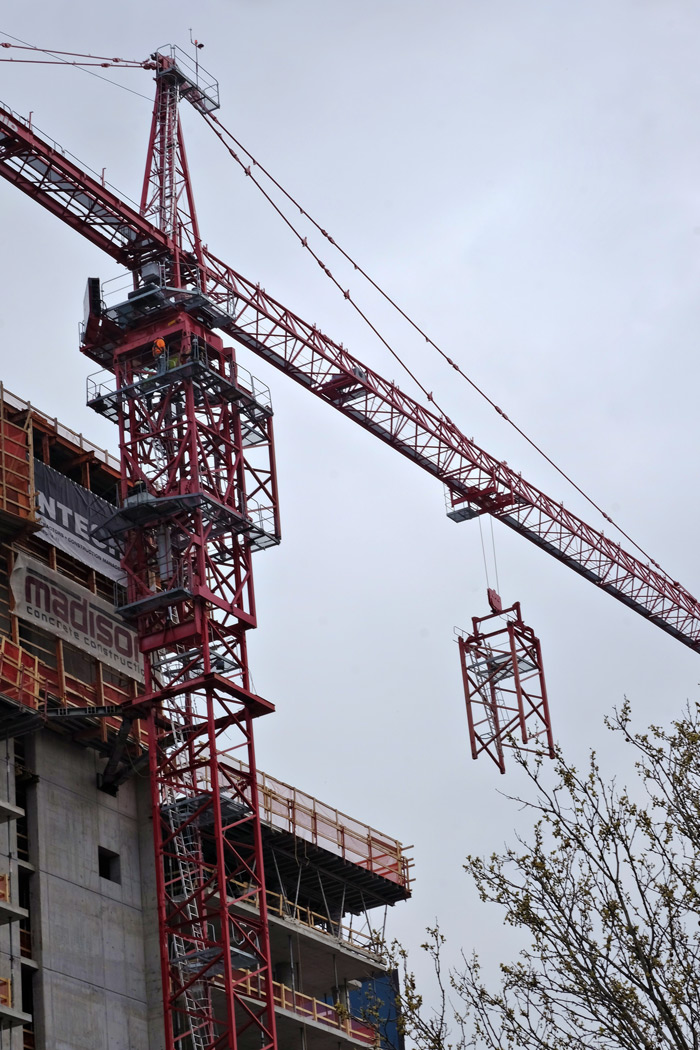Hole in the Clouds
Oct 4, 2011
 A tour guide from the Tenement Museum points out features of the neighborhood surrounding the Forward Building at 175 Broadway in New York's Lower East Side.
A tour guide from the Tenement Museum points out features of the neighborhood surrounding the Forward Building at 175 Broadway in New York's Lower East Side.
The Daily Forward was founded at the turn of the twentieth century as a Yiddish-language newspaper for new immigrants from Eastern Europe who were then crowding into the Lower East Side and similar neighborhoods in other American cities. Forward readers were mostly poor people struggling to get a foothold in a new, strange land; the newspaper was active politically as well as editorially in the labor union movement and on behalf of an American Socialist party, and it also promoted cultural Americanization, particularly with respect to Old World Jewish religiosity, which the editors rejected in favor of a more secular and open-minded cultural identity. Among the writers: Isaac Bashevis Singer and Leon Trotsky.
I remember seeing my grandparents reading The Forward on the front porch of their rowhouse in Baltimore in the 1950s. Yiddish was all Greek to me, but I distinctly recall how amusing it seemed that a newspaper called Forward was printed backward.
The irony doesn't stop there, however. The Forward Building in this photo, built by the Socialist publishers in 1917 when circulation exceeded a quarter of a million, was converted to condominiums in the 1990s; I've been told that units in the building start at more than $2 million. The Lower East Side of Manhattan is still a landing place for new immigrants–note the signs in Chinese on the two buildings at the right edge of the picture–but gentrification now attracts rich people to the neighborhood as well. There may still be sweatshops here, but the pushcarts are definitely gone.
The Forward survives today, though just barely, in weekly English and Yiddish editions, each with a circulation of a few thousand.
New York
streetscape
Lower East Side
immigration
Forward
condominiums
Yiddish
Apr 6, 2016
 This crane has been caught in the act of growing itself. The object it's lifting into the air is a 20-foot section of crane-tower that it is about to swing into place to lengthen its own neck and make itself taller. The new section will be inserted at the top of the neck, which is currently at a level near the top of the building, where a sort of cage structure surrounds the tower.
This crane has been caught in the act of growing itself. The object it's lifting into the air is a 20-foot section of crane-tower that it is about to swing into place to lengthen its own neck and make itself taller. The new section will be inserted at the top of the neck, which is currently at a level near the top of the building, where a sort of cage structure surrounds the tower.
This cage is called a climbing frame, and it costs $60,000 to rent for a weekend. For a crane that wants to grow itself, the climbing frame is the secret to the whole pulling-itself-up-by-its-own-bootstraps thing.
The climbing frame is installed around the top of the crane's neck, just below the horizontal part of the crane, which does all the heavy lifting. The horizontal arm, with its gears and motor, has to be unbolted from the tower and settled onto the top of the climbing frame. Hydraulic jacks in the frame then boost it up, leaving a gap in the tower. The crane simply picks up a new section of tower and slips it into the gap.
Over the course of a few hours on Monday, this crane grew by six sections, 120 feet. We're told it's now as tall as it needs to be for the project–condos, of course, along the Schuylkill riverfront. In June, the crane guys say they'll be back to dismantle the whole thing and move it to its next job.
How will it ungrow itself? It can't. It's not a cannibal. Sometimes the crane will haul up a second, smaller crane onto the roof of the finished building, and the smaller crane will then lower the pieces of the big crane. To get the second crane down, they sometimes have to use a third, even smaller crane, which can be disassembled into pieces small enough to go down the elevator.

work
construction
crane
condominiums
Schuylkill riverfront
(Image credits: Fuji T)
 A tour guide from the Tenement Museum points out features of the neighborhood surrounding the Forward Building at 175 Broadway in New York's Lower East Side.
A tour guide from the Tenement Museum points out features of the neighborhood surrounding the Forward Building at 175 Broadway in New York's Lower East Side.
